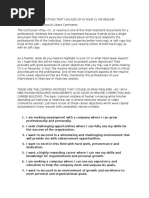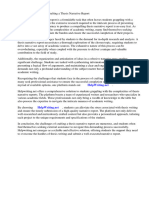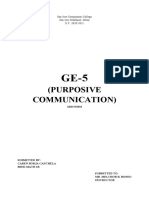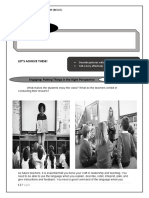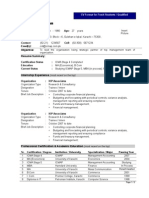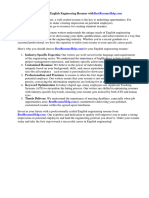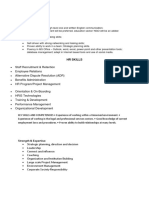Ge115 Final Module
Ge115 Final Module
Uploaded by
kantontonesCopyright:
Available Formats
Ge115 Final Module
Ge115 Final Module
Uploaded by
kantontonesOriginal Title
Copyright
Available Formats
Share this document
Did you find this document useful?
Is this content inappropriate?
Copyright:
Available Formats
Ge115 Final Module
Ge115 Final Module
Uploaded by
kantontonesCopyright:
Available Formats
SOUTH EAST ASIAN INSTITUTE OF TECHNOLOGY, INC.
National Highway, Crossing Rubber, Tupi, South Cotabato
GENERAL EDUCATION DEPARTMENT
___________________________________________________
LEARNING MODULE
FOR
GE 115: PURPOSIVE COMMUNICATION
_____________________________________________________
WEEK 11
April__,2024
GE 115: Purposive Communication
SOUTH EAST ASIAN INSTITUTE OF TECHNOLOGY, INC.
Page - 11 - of 23
COURSE OUTLINE
COURSE CODE : GE 115
TITLE : Purposive Communication
TARGET POPULATION : All Students
INSTRUCTOR : Ms. Nemia M. Labuayan, LPT
Overview:
This course introduces the concepts of literacy as a collection of shared cultural practices and
evolving social phenomena. The course will provide a series of field based and interdisciplinary
explorations, which will lead students to characterize a literature person as having wide range of
skills, competencies, abilities and attitude that are transferrable across learning areas. As such
learning opportunities shall focus on examining problematizing and stimulating the age-specific
teaching of new literacies necessary in the 21st century.
Objectives:
1. Demonstrate mastery in elucidating the nature, elements, and functions of verbal and
non-verbal communication in various and multicultural contexts.
2. Respond through written and oral communication to the challenges of diverse and
multicultural communication.
3. Demonstrate mastery in obtaining, providing, and disseminating information.
4. Communicate ideas effectively using the different forms of communication in the work
field.
5. Demonstrate mastery of the key concepts to effectively and ethically communicate in the
chosen field.
The following are the topics to be discussed
Week 13 COMMUNICATION FOR NURSES AND
COMMUNICATION FOR JOURNALISTS
Week 14 COMMUNICATION FOR TOURISM AND
COMMUNICATION FOR TEACHERS
Week 15 COMMUNICATION FOR BUSINESS AND TRADE
Week 16 COMMUNICATION FOR EMPLOYMENT
Week 17 COMMUNICATION WITHIN A COMPANY
GE 115: Purposive Communication
SOUTH EAST ASIAN INSTITUTE OF TECHNOLOGY, INC.
Page - 11 - of 23
Instruction to the Learners
Each chapter in this module contains lessons involving the nature and elements of purposive
communication. The units are characterized by continuity and are arranged in such a manner that
the present unit is related to the next unit. For this reason, you are advised to read this module.
After each unit, there are exercises to be given. Submission of task given will be every
____________ during your scheduled class hour.
WEEK 11
COMMUNICATION FOR WORK PURPOSES
A. COMMUNICATION FOR NURSES: WRITING BASIC PATIENT NOTES
Patient’s notes record the assessment of the patient’s condition before, during, and
after the treatment.
Classified Notes:
1. Initial notes -refer to the first or earliest assessment.
2. Interim or progress notes -refer to the assessment reports done in
order to monitor the patient’s condition.
3. Discharge notes -reports given once medication is discontinued or
the patient is released from the hospital.
SOAP Format
Subjective (assessment given by the family member or patient himself)
Objective (assessment seen by you or reflected in laboratory or other medical
reports)
Assessment (diagnosis)
Plan (procedures to be done to address the diagnosis)
B. COMMUNICATION FOR JOURNALISTS: WRITING A LEAD
Writing the opening paragraph of a news article or the lead is one of the most
challenging tasks. The manner of presenting the lead may dissuade the readers from
reading the entire news article. Lead gives readers the most important information in a
clear, concise, and interesting manner. It also establishes the voice and direction of an
article.
GE 115: Purposive Communication
SOUTH EAST ASIAN INSTITUTE OF TECHNOLOGY, INC.
Page - 11 - of 23
Tips for Writing a Lead
The Five W’s and H. Before writing a lead, decide which aspect of the story -
who, what, when, where, why, how -is important. You should emphasize those
aspects in your lead.
Conflict. Good stories have conflict. So do many leads.
Specificity. Be specific as possible.
Brevity. Readers want to know why the story matters to them, and they won’t
wait long for the answer. Leads are often one to two sentences.
Active sentence. Strong verbs will make your lead lively and interesting. Passive
constructions, on the other hand, can sound dull and leave out important
information.
Honesty. A lead is an implicit promise to your readers. You must be able to
deliver what you promise in your lead.
WHAT TO AVOID
1. Flowery language: Many beginning writers make the mistake of overusing adverbs and
adjectives in their leads. Concentrate instead on using strong verbs and nouns.
2. Unnecessary words or phrases: Watch out for unintentional redundancy. For example, 2
p.m. Wednesday afternoon, or very unique. You can’t afford to waste space in a news
story, especially in the lead. Avoid clutter and cut right to the heart of the story.
3. Formulaic leads: Because a lot of news writing is done on deadline, the temptation to write
tired leads is strong. Resist it. Readers want information, but they also want to be
entertained. Your lead must sound genuine, not merely mechanical.
4. It: Most editors frown on leads that begin with the word it because it is not precise and
disorients the reader.
TYPES OF LEADS
Summary lead: This is perhaps the most traditional lead in news writing. It is often used for
breaking news. A story about a city council vote might use this “just the facts” approach. Straight
news leads tend to provide answers to the most important three or four of the Five W’s and H.
Historically this type of lead has been used to convey who, what, when and where. But in today’s
fast-paced media atmosphere, a straightforward recitation of who, what, when and where can
sound stale by the time a newspaper hits the stands. Some newspapers are adjusting to this
GE 115: Purposive Communication
SOUTH EAST ASIAN INSTITUTE OF TECHNOLOGY, INC.
Page - 11 - of 23
reality by posting breaking news online as it happens and filling the print edition with more
evaluative and analytical stories focused on why and how. Leads should reflect this.
Anecdotal lead: Sometimes, beginning a story with a quick anecdote can draw in readers. The
anecdote must be interesting and must closely illustrate the article’s broader point. If you use this
approach, specificity and concrete detail are essential and the broader significance of the
anecdote should be explained within the first few sentences following the lead.
Other types of leads: A large number of other approaches exist, and writers should not feel
boxed in by formulas. That said, beginning writers can abuse certain kinds of leads. These include
leads that begin with a question or direct quotation and those that make a direct appeal using the
word you. While such leads might be appropriate in some circumstances, use them sparsely and
cautiously.
EXAMPLES
Summary lead:
County administrator faces ouster
By Tony Cook for the Cincinnati Post, Jan. 14, 2005
Two Hamilton County Commissioners plan to force the county’s top administrator out of
office today.
Commentary: This lead addresses the traditional who, what and when. If this information had
been reported on TV or radio the day before, this lead might not be a good one for the print edition
of the newspaper; however, if the reporter had an exclusive or posted this information online as
soon as it became available, then this lead would make sense. Note that it is brief (15 words) and
uses an active sentence construction.
Summary lead:
Lobbyists flout disclosure rules in talks with commissioners
By Tony Cook and Michael Mishak for the Las Vegas Sun, July 13, 2008
On more than 170 occasions this year, lobbyists failed to file disclosure forms when they
visited Clark County commissioners, leaving the public in the dark about what issues they
GE 115: Purposive Communication
SOUTH EAST ASIAN INSTITUTE OF TECHNOLOGY, INC.
Page - 11 - of 23
were pushing and on whose behalf.
Commentary: This lead is more representative of the less timely, more analytical approach that
some newspapers are taking in their print editions. It covers who, what and when, but also why it
matters to readers. Again, it uses active verbs, it is specific (170 occasions) and it is brief (35
words).
Anecdotal lead:
Tri-staters tell stories of the devastating tsunami
By Tony Cook for the Cincinnati Post, Jan. 8, 2005
From Dan Ralescu’s sun-warmed beach chair in Thailand, the Indian Ocean began to look,
oddly, not so much like waves but bread dough.
Commentary: This article is a local angle on the devastating tsunami that struck Southeast Asia
in 2005. As a result of the massive death toll and worldwide impact, most readers would have
been inundated with basic information about the tsunami. Given that context, this lead uses an
unexpected image to capture the reader’s attention and prepare them for a new take on the
tsunami. Again, it is brief (23 words).
Question lead:
Same lobbyist for courts, shorter term, more money
By Tony Cook for the Las Vegas Sun, June 29, 2008
What’s increasing faster than the price of gasoline? Apparently, the cost of court lobbyists.
District and Justice Court Judges want to hire lobbyist Rick Loop for $150,000 to represent
the court system in Carson City through the 2009 legislative session. During the past
session, Loop’s price tag was $80,000.
Commentary: Question leads can be useful in grabbing attention, but they are rarely as effective
as other types of leads in terms of clearly and concisely providing the main point of a story. In this
case, the second paragraph must carry a lot of the weight that would normally be handled in the
lead.
GE 115: Purposive Communication
SOUTH EAST ASIAN INSTITUTE OF TECHNOLOGY, INC.
Page - 11 - of 23
ACTIVITY #11
(To be submitted on April____, 2024)
Direction: Read and understand the module and answer the following. Write your answer in a 1
whole sheet of yellow pad paper.
Task: 1. Write a poem about what a budding journalist should remember in writing a lead.
L-______________________________________________________________
E-______________________________________________________________
A-______________________________________________________________
D-______________________________________________________________
Rubric:
Level Description
Well written and very organized. Excellent grammar mechanics.
Outstanding Clear and concise statements.
(9-10 points) Excellent effort and presentation with details.
Demonstrate a thorough understanding of the topic.
Writes fairly clear. Good grammar mechanics.
Good
Good presentation and organization.
(7-8 points)
Sufficient effort and detail.
Minimal effort. Good grammar mechanics.
Fair
Fair presentation.
(6 points)
Few supporting details.
Somewhat unclear. Shows little effort. Poor grammar mechanics.
Poor
Confusing and choppy, incomplete sentences.
(4-5 points)
No organization of thoughts.
Lacking effort. Very poor grammar mechanics.
Very Poor Very unclear.
(1-3 points) Does not address topic.
Limited attempt.
End of Eleventh week
---------------------------------------------Nothing Follows--------------------------------
GE 115: Purposive Communication
SOUTH EAST ASIAN INSTITUTE OF TECHNOLOGY, INC.
Page - 11 - of 23
SOUTH EAST ASIAN INSTITUTE OF TECHNOLOGY, INC.
National Highway, Crossing Rubber, Tupi, South Cotabato
GENERAL EDUCATION DEPARTMENT
___________________________________________________
LEARNING MODULE
FOR
GE 115: PURPOSIVE COMMUNICATION
_____________________________________________________
WEEK 12
April___, 2024
GE 115: Purposive Communication
SOUTH EAST ASIAN INSTITUTE OF TECHNOLOGY, INC.
Page - 11 - of 23
WEEK 12
C. COMMUNICATION FOR TOURISM: TOUR GUIDING
“The world is a book, and those who do not travel read only one page.”
-Saint Augustine
Tourism is travel for recreational, leisure or business purposes. Like other business,
tourism is highly perishable. Hotel with no booking, buses, and airlines with no passengers lose
their value. Promotion of tourism, therefore, is necessary to sustain the industry. This is where tour
guides contribute best.
Communicative Goals in Tour Guiding
Inform, remind and advise. This goal includes giving directions and commentaries,
explaining itineraries, reminding tourists of safety tips and security, describing weather
conditions and situations, challenges in the place, etc.
Promote and persuade. This is to sow interest in people to visit places.
Clarify. Misinformation often leads to misunderstanding and confusion.
Build rapport and relationships. Good conversations with tourists lead to good rapport.
Good rapport reinforces more business transactions and business network.
Gather feedback for improvement. Open communication with tourists is an avenue of
evaluating the service provided. Constructive feedback is used as basis for changes to
improve tour guiding services while positive feedback inspires tour guides to sustain the
quality of the work.
Communication Tasks for Tour Guides
Receiving telephone calls. The way one handles a telephone may be first impression that
a company makes on a prospective client.
o Always have a notepad and a pen near the telephone.
o Pick up the phone after two or three rings.
o Greet the caller and identify yourself and your enterprise.
GE 115: Purposive Communication
SOUTH EAST ASIAN INSTITUTE OF TECHNOLOGY, INC.
Page - 11 - of 23
o Ask what you can do for the caller.
o Write down the message for completeness and reference especially if the message
is to be relayed to another person or if the message is long.
o Express your joy of having answered the caller’s query.
Preparing an itinerary. Itineraries are prepared primarily to estimate the time to be spent
in each site and to systematize the whole tour experience.
Giving tour commentary. It is delivered while tourists are riding on a tour bus. The
commentary provides descriptions, history, trivia, anecdotes, and any relevant and
interesting information.
D. COMMUNICATION FOR TEACHERS: STORYTELLING
One of the responsibilities of teachers is stimulating their students’ imaginations and
understanding of the world. One approach that is commonly used is storytelling. Stories,
according to Aiex (1998), play significant roles in students’ growth and through these, they
would learn to appreciate literature.
Storytelling is a powerful way of communicating and conveying emotion by
improvisation or embellishment. It is the art of using language, voice, movements, and
gestures in order to reveal images and elements of the story to an audience.
Reasons why storytelling is recommended as a strategy for teaching:
Cooter (1991) and Bla (1998) forwarded that the excitement and drama of
storytelling provide a context that holds student’s attention.
Stories are an enormous language treasure. Storytelling is one of the oldest arts
of telling morals and thousands of these stories have been created and passed
down.
Storytelling provides a lively atmosphere and a real-life environment that
encourages the students to participate.
GE 115: Purposive Communication
SOUTH EAST ASIAN INSTITUTE OF TECHNOLOGY, INC.
Page - 11 - of 23
ACTIVITY #12
(To be submitted on Tuesday, April___, 2024)
Direction: Make a 3-4 promotional video for a potential tourist destination in your area. Be sure to
include a good tour commentary in your video.
Criteria for judging:
Clarity of Voice 20%
Quality or Technicality of the Video 30%
Content of the Video 35%
Adherence to Time Limit 15%
Total 100%
End of Twelfth week
---------------------------------------------Nothing Follows--------------------------------------
GE 115: Purposive Communication
SOUTH EAST ASIAN INSTITUTE OF TECHNOLOGY, INC.
Page - 11 - of 23
SOUTH EAST ASIAN INSTITUTE OF TECHNOLOGY, INC.
National Highway, Crossing Rubber, Tupi, South Cotabato
GENERAL EDUCATION DEPARTMENT
___________________________________________________
LEARNING MODULE
FOR
GE 115: PURPOSIVE COMMUNICATION
_____________________________________________________
WEEK 13
April___, 2024
GE 115: Purposive Communication
SOUTH EAST ASIAN INSTITUTE OF TECHNOLOGY, INC.
Page - 11 - of 23
WEEK 13
E. COMMUNICATION FOR BUSINESS AND TRADE
1. Definition and Relevance
A SWOT analysis or a SWOT matrix is a diagram that shows an
organization’s or person’s key strengths, weaknesses, opportunities, and threats.
Doing this type of analysis, any organization, corporation, or company can innovate
or adapt new ways or strategies to put itself better in the corporate world.
2. Internal factors and External factors
Internal factors are thighs that we can control.
External factors are thighs we cannot control.
3. How to make a SWOT analysis
Make sure that the analysis heads to the right path or direction by defining your
objective. If your study focuses on what matters, this will eventually provide you a
right strategy.
Focus on the internal and external factors.
i. Strengths. Identify the things that do better in your company rather than the
competition.
ii. Weakness. In what areas are your competitors outclassing your company?
What holds your business back? Are there any thighs you can avoid?
iii. Opportunities. Opportunities can help your company grow.
iv. Threats. Are there obstacles stopping your company from growing?
F. WRITING BUSINESS AND TECHNICAL REPORT
A Report is a comprehensive document that covers all aspects of the subject
matter of study. It presents results of an experiment, investigation, research, or an
inquiry to a specific audience.
GE 115: Purposive Communication
SOUTH EAST ASIAN INSTITUTE OF TECHNOLOGY, INC.
Page - 11 - of 23
Report Categories
I. The Informal Report
It functions to inform, analyse, and recommend. It may be in the form of
a memo, financial report, monthly activities report, development report,
research, etc.
It is written according to an institution’s style and rules. It is used for
conveying routine messages.
Types of Informal Report
A. Progress Report -written to provide information about the way a project is
developing.
B. Sales Activity Report -helps a firm to understand about the progress of
the salespeople and identify the shortcomings.
C. Personnel Evaluation -used by an organization to assess an employee’s
performance.
D. Financial Report -presents formal record of the financial activities of a
business, person, or other entries.
E. Feasibility Report -assess the viability of a new project; details whether a
project should be undertaken and the reasons for that decision.
F. Literature Review -conveys to the readers the work already done and the
knowledge and ideas that have been already established on a topic of
research.
G. Credit Report -details report of an individual’s credit history prepared by e
credit bureau.
II. The Formal Report
It is an official report that contains a collection of detailed information,
research, and data necessary to make decisions. It is formal, complex
and used at an official level.
GE 115: Purposive Communication
SOUTH EAST ASIAN INSTITUTE OF TECHNOLOGY, INC.
Page - 11 - of 23
It is often a written account of a major project. It may be in the form of
launching a new technology or a new project line, results of a study or
an experiment, a review of developments in the field, etc.
Types of Formal Report
A. Informal Report -provides data, facts, feedback, and other types of
information without analysis or recommendations.
B. Analytical Reports -it goes beyond presenting results.
C. Recommendation Reports -advocates a course of action. This usually
presents the results and conclusions that support the recommendation.
D. Research Reports – most widely used report usually in university levels.
E. Case Study Analysis Reports -includes real life examples.
ACTIVITY #13
(To be submitted on April___, 2024)
Direction: Read and understand the module and answer the following. Write your answer in a 1
whole sheet of yellow pad paper.
Task: 1. Create your personal SWOT Analysis
Directions: Imagine you are going to apply as a marketing director, accountant, general manager,
financial analyst, or any position you wish in a corporate world.
A. Assess yourself first by listing your potentials, capabilities, talents, skills or skills to
improve in a draft.
B. Edit and proofread your work. You may write the items in phrases. Observe
parallelism in writing the items.
C. Use the matrix below to plot your own SWOT.
GE 115: Purposive Communication
SOUTH EAST ASIAN INSTITUTE OF TECHNOLOGY, INC.
Page - 11 - of 23
Rubric:
Level Description
Well written and very organized. Excellent grammar mechanics.
Outstanding Clear and concise statements.
(9-10 points) Excellent effort and presentation with details.
Demonstrate a thorough understanding of the topic.
Writes fairly clear. Good grammar mechanics.
Good
Good presentation and organization.
(7-8 points)
Sufficient effort and detail.
Minimal effort. Good grammar mechanics.
Fair
Fair presentation.
(6 points)
Few supporting details.
Somewhat unclear. Shows little effort. Poor grammar mechanics.
Poor
Confusing and choppy, incomplete sentences.
(4-5 points)
No organization of thoughts.
Lacking effort. Very poor grammar mechanics.
Very Poor Very unclear.
(1-3 points) Does not address topic.
Limited attempt.
End of thirteenth week
---------------------------------------------Nothing Follows--------------------------------
GE 115: Purposive Communication
SOUTH EAST ASIAN INSTITUTE OF TECHNOLOGY, INC.
Page - 11 - of 23
SOUTH EAST ASIAN INSTITUTE OF TECHNOLOGY, INC.
National Highway, Crossing Rubber, Tupi, South Cotabato
GENERAL EDUCATION DEPARTMENT
___________________________________________________
LEARNING MODULE
FOR
GE 115: PURPOSIVE COMMUNICATION
_____________________________________________________
WEEK 14
April___, 2024
GE 115: Purposive Communication
SOUTH EAST ASIAN INSTITUTE OF TECHNOLOGY, INC.
Page - 11 - of 23
WEEK 14
COMMUNICATION FOR EMPLOYMENT
THE RESUME
A resume is a persuasive summary of your qualifications for employment. If you are in the
job market, having a resume makes you look well organized and prepared to your prospective
employers.
Types of Resume
Print resumes are printed on paper for prospective employers to scrutinize. They are
designed to emphasize key information using bold or italic typeface.
GE 115: Purposive Communication
SOUTH EAST ASIAN INSTITUTE OF TECHNOLOGY, INC.
Page - 11 - of 23
Scannable resumes are designed to be read by computers; hence, they are to be
formatted using single typeface or without italics or bold.
GE 115: Purposive Communication
SOUTH EAST ASIAN INSTITUTE OF TECHNOLOGY, INC.
Page - 11 - of 23
Features of a Resume
Organization
a. Chronological resume is the general listing of all your academic and work
experience from the most recent to the oldest.
b. Functional resume is organized around various kinds of experiences. If you wish to
demonstrate a lot of experience in more than one area and if you wish to downplay
dates.
GE 115: Purposive Communication
SOUTH EAST ASIAN INSTITUTE OF TECHNOLOGY, INC.
Page - 11 - of 23
c. Targeted resume generally announces the specific goal up to top, just beneath your
name, and offers information selectively. You can show the experience and skills
relevant to your goal.
Succinctness
A resume must be concise. Entries may not be written in sentences but should be
parallel. For print resume, use action verbs rather than nouns to emphasize your
accomplishments. For scannable resume, use nouns rather than verbs as key
words.
Comprehensiveness
A resume must present all important details than can gain the nod of the prospective
employer. Check all information you provided.
Design
The resume should be reader-friendly and be professionally packaged. For print
resume, use appropriate spacing, section headings, and uniform typeface for each
heading. Scannable resume shall only have one standard typeface.
THE APPLICATION LETTER
An application letter is generally as a formal introduction of yourself to your
prospective employer.
Features of an Application Letter
Qualifications
Make clear why you’re interested in the position or the organization, to indicate what
skills you possess that matches what the company is looking for or to stipulate why
the person you’re writing to should at least want to meet you.
Pleasing Tone
Go beyond simply stating your accomplishments. Through your words, you need to
demonstrate that you will be the kind of employee the organization wants.
Presentation is also important -your letter should be neat and error-free.
GE 115: Purposive Communication
SOUTH EAST ASIAN INSTITUTE OF TECHNOLOGY, INC.
Page - 11 - of 23
Format
Application letter typically follows a prescribed format, which is a conventional
business-like format. The most common is the block format.
GE 115: Purposive Communication
SOUTH EAST ASIAN INSTITUTE OF TECHNOLOGY, INC.
Page - 11 - of 23
Guidelines for Writing an Application Letter
Focus. Application letter is not personal and should not be chatty. Keep it focused: when
you’re applying for a position, include only relevant position.
Stay on topic. State the reason for the letter.
Think of your letter as an argument. When you’re asking for a job, you’re making an
argument. You’re making a claim -that your qualified for a certain position -and you need to
support your claim with reasons and evidence.
Choose an appropriate salutation. If you know the person’s name and title, use it: “Dear
Attorney Lim.” If you don’t know the person’s title, one good solution is to address him or
her on first and last name: “Dear Jean Chavez” or to an unknown reader, use “Dear Sir or
Madam.”
Proofread. To compete, strive for perfection.
ACTIVITY #14
(To be submitted on April___, 2024)
Direction: Construct your own resume and application letter in a short bond paper. Follow the
format and choose your own position and the company you wanted to be part on.
End of Fourteenth week
---------------------------------------------Nothing Follows--------------------------------------
GE 115: Purposive Communication
SOUTH EAST ASIAN INSTITUTE OF TECHNOLOGY, INC.
Page - 11 - of 23
SOUTH EAST ASIAN INSTITUTE OF TECHNOLOGY, INC.
National Highway, Crossing Rubber, Tupi, South Cotabato
GENERAL EDUCATION DEPARTMENT
___________________________________________________
LEARNING MODULE
FOR
GE 115: PURPOSIVE COMMUNICATION
_____________________________________________________
WEEK 15
June___,2022
GE 115: Purposive Communication
SOUTH EAST ASIAN INSTITUTE OF TECHNOLOGY, INC.
Page - 11 - of 23
WEEK 15
COMMUNICATION WITHIN A COMPANY
THE MEMORANDUM
The word “memo” is derived from the Latin “memorare” changed to “memorandus”
and means “to state” or “to tell”. In an organization, it takes the form of a short official note that one
writes to a person or to several individuals such as members, faculty, heads of offices and the like.
Joe LoCicero (2007) offers a good example of when to use memos. He claims that
memos may inform the readers of:
Announcements for diverse occasions.
Changes such as policies, procedures or processes.
Confirmations of discussions, decisions and meetings.
Documents for submission such as reports, data, research and results of survey.
Recommendations.
Requests for further information.
Solicitations for opinions.
GE 115: Purposive Communication
SOUTH EAST ASIAN INSTITUTE OF TECHNOLOGY, INC.
Page - 11 - of 23
THE MINUTES OF MEETING
Serves as an official record, aids in refreshing memories of participants, supplies
information to individuals who were not present, and help prepare members for upcoming
meetings. Minutes should succinctly and truthfully account all pertinent information that transpired
in a meeting.
Robert’s New Rule of Order
Robert’s Rule of Order (2005) recommends that minutes contain the following items:
Committee or organization name
Kind of meeting (regular board meeting, an annual meeting, a meeting of the housing
committee or a special meeting)
Date, location, and time of beginning and adjournment.
Names of the chair and secretary or their subordinates
Names of all present members
Names of guests and their role in the meeting
Reference to approval of last meeting’s minutes
Motions raised
Report
Other special concerns from committees or individual members
The signature of the secretary upon the approval of the minutes
GE 115: Purposive Communication
SOUTH EAST ASIAN INSTITUTE OF TECHNOLOGY, INC.
Page - 11 - of 23
What should we excluded in the minutes?
GE 115: Purposive Communication
SOUTH EAST ASIAN INSTITUTE OF TECHNOLOGY, INC.
Page - 11 - of 23
The minutes are a factual record of business. Robert’s Rule of Order (2005) recommends
that the following be excluded from a minutes:
1. Condemnation or honors: Crtiicism of members should not be recorded unless it takes
the form of an official motion. Expressions of gratitude should only be included with
permission of the participants.
2. Discussion:Whatever statement was given by the members must be recorded
objectively.
3. Extended repeating of reports: Just hit highpoints or key facts, mostly if there is an
attachment of a written report.
4. Opinions or judgments: Omit accounts like “well-done report” or a “heated discussion.”
Who should write the Minutes?
The minutes are documents significant to an organization. In any kind of meeting, one must
take the role of a note taker, a secretary, or a recorder.
The person who takes the meeting minutes is usually a member of the organization or
institution and takes note of the meeting proceedings while taking part in the conference,
assembly, session, or discussion.
In government or legal meetings, an outsider must be the note taker or recorder to avoid
biases and maintain impartiality. He or she, however, must have full knowledge of the adapted
parliamentary process to be able to effectively carry out the role.
In some cases, the same person takes the minute at each meeting. In others, the role of
minute taker passes from member or participate to participant. The role of the recorder builds
effective leadership skills, effective communication, and full involvement of members.
ACTIVITY #15
(To be submitted on April___, 2024)
Direction: Read and understand the module and answer the following. Write your answer in a 1
whole sheet of yellow pad paper. Answers should be composed of at least five (5) sentences (10
points each). Follow the rubric given at week 15 as your guide.
1. Explain the significance of a Minutes to an organization.
GE 115: Purposive Communication
SOUTH EAST ASIAN INSTITUTE OF TECHNOLOGY, INC.
Page - 11 - of 23
You might also like
- Summary Chapter I To V (Io Psych Aamodt)Document10 pagesSummary Chapter I To V (Io Psych Aamodt)Joseanne Marielle75% (4)
- Effective Human Relations Interpersonal and Organizational Applications 12th Edition Reece Solutions ManualDocument5 pagesEffective Human Relations Interpersonal and Organizational Applications 12th Edition Reece Solutions Manuala156320293No ratings yet
- Top 10 Career Objectives That Can Add Up in Your CV or ResumeDocument9 pagesTop 10 Career Objectives That Can Add Up in Your CV or Resumeavinash50% (2)
- COM 2512-Module - KPMBP PDFDocument132 pagesCOM 2512-Module - KPMBP PDFJapyNo ratings yet
- South East Asian Institute of Technology, Inc. National Highway, Crossing Rubber, Tupi, South CotabatoDocument28 pagesSouth East Asian Institute of Technology, Inc. National Highway, Crossing Rubber, Tupi, South CotabatoMark HernandezNo ratings yet
- Chapter 4 Lesson 1 9Document42 pagesChapter 4 Lesson 1 9Aldren DanuyaNo ratings yet
- South East Asian Institute of Technology, Inc. National Highway, Crossing Rubber, Tupi, South CotabatoDocument26 pagesSouth East Asian Institute of Technology, Inc. National Highway, Crossing Rubber, Tupi, South CotabatoKristine Lagumbay GabiolaNo ratings yet
- Local Media857529125302663238Document20 pagesLocal Media857529125302663238Joan Batiancila TarreNo ratings yet
- Module 2 + Lesson 1 - 4Document65 pagesModule 2 + Lesson 1 - 4Lowell VenerableNo ratings yet
- 3-23-2021 Communication-For-Work-PurposesDocument23 pages3-23-2021 Communication-For-Work-PurposesJamesvan NaronNo ratings yet
- Q3_SPJ4_Module-7Document8 pagesQ3_SPJ4_Module-7Nanay & The GangNo ratings yet
- English6 Q3 Week2 D5 EN10LC IIId 3.18Document4 pagesEnglish6 Q3 Week2 D5 EN10LC IIId 3.18hazelkaye.tejeroNo ratings yet
- Discipline and Ideas in Applied SS Module 5Document5 pagesDiscipline and Ideas in Applied SS Module 5G BoyNo ratings yet
- Thesis Narrative ReportDocument8 pagesThesis Narrative Reportafcmayfzq100% (1)
- Eapp q2 Module 9Document21 pagesEapp q2 Module 9Edsel Hormachuelas100% (1)
- ENGLISH 6 - WHLP Week 4 March 6 10Document4 pagesENGLISH 6 - WHLP Week 4 March 6 10JOEL CABIGONNo ratings yet
- PGDMCOM - 105session2019 20 PDFDocument14 pagesPGDMCOM - 105session2019 20 PDFJimmy DhillonNo ratings yet
- A Handout in Purposive Communication 222Document3 pagesA Handout in Purposive Communication 222JimJim PajenadoNo ratings yet
- Study MaterialDocument109 pagesStudy Materialu23776812No ratings yet
- Discipline and Ideas in The Applied Social Science (DIASS) : Quarter 2 Module 3Document14 pagesDiscipline and Ideas in The Applied Social Science (DIASS) : Quarter 2 Module 3MJ TV100% (1)
- English 10 Quarter 4 Week 7 EUNICE C. ADADocument35 pagesEnglish 10 Quarter 4 Week 7 EUNICE C. ADATel Tel HitaladaNo ratings yet
- Ge-8 Week 5&6Document7 pagesGe-8 Week 5&6Rica CanchelaNo ratings yet
- Ge-8 Week 5&6 (Canchela)Document7 pagesGe-8 Week 5&6 (Canchela)Rica CanchelaNo ratings yet
- Emtech Melc19 Las Sy 2024-25Document3 pagesEmtech Melc19 Las Sy 2024-25AriNo ratings yet
- St. Louis College of Bulanao: BloggingDocument6 pagesSt. Louis College of Bulanao: BloggingJess ArceoNo ratings yet
- Business Communication M-203Document150 pagesBusiness Communication M-203Niranjan GoudNo ratings yet
- TNCT Q3 Module5Document18 pagesTNCT Q3 Module5Glenn Mendez100% (2)
- MIL11 Q4 MOD5 v1Document63 pagesMIL11 Q4 MOD5 v1Chessman Gege0% (2)
- Purposive CommunicationDocument28 pagesPurposive CommunicationBAI XYRYLL SANANGNo ratings yet
- Module 5 Week 7 and Week 8 PURPOSIVE COMM Final - EditedDocument9 pagesModule 5 Week 7 and Week 8 PURPOSIVE COMM Final - EditedPauline SalangsangNo ratings yet
- English: Quarter I - Module IDocument45 pagesEnglish: Quarter I - Module ISa Aking Mga Kabata50% (2)
- G10 Quarter I NewDocument40 pagesG10 Quarter I NewMadali Lovie FlorNo ratings yet
- PurposiveDocument26 pagesPurposiveCHANTRA MARIE FORGOSA100% (1)
- MIL11 Q4 MOD5 v1Document65 pagesMIL11 Q4 MOD5 v1jeromee mendozaNo ratings yet
- ENG1Document63 pagesENG1Earl PecsonNo ratings yet
- OC LAS 11 Principles of Speech WritingDocument6 pagesOC LAS 11 Principles of Speech WritingJaiseo FunumichiNo ratings yet
- English 9-Q4_M2Document16 pagesEnglish 9-Q4_M2Maria Ginalyn Janda QuiñonesNo ratings yet
- Las Eng10 Q3 W1Document7 pagesLas Eng10 Q3 W1Janine MolinesNo ratings yet
- Eapp Q2 Las 2 0 3Document2 pagesEapp Q2 Las 2 0 3Winsear VardeNo ratings yet
- Eapp Q4 Week3Document16 pagesEapp Q4 Week3Christine Sta AnaNo ratings yet
- Module 8 GEC 5-2Document4 pagesModule 8 GEC 5-2Trisha Bendaña ReyesNo ratings yet
- TOR SMIC Untuk ReviewerDocument11 pagesTOR SMIC Untuk ReviewerfaisalNo ratings yet
- Examples of Effective and Ineffective Thesis StatementsDocument6 pagesExamples of Effective and Ineffective Thesis StatementsHowToFindSomeoneToWriteMyPaperCanada100% (2)
- Chapter 5 Eng01 Purposive CommunicationDocument11 pagesChapter 5 Eng01 Purposive CommunicationAngeline Silagan100% (1)
- Oral Com Class 3Document14 pagesOral Com Class 3ganganohelenNo ratings yet
- English MaterialDocument7 pagesEnglish MaterialSYSLORI 56No ratings yet
- Oral Communication: Quarter 2 Week 5Document10 pagesOral Communication: Quarter 2 Week 5April Love Albelda PaladNo ratings yet
- Module 1.2 - Purposive CommunicationDocument6 pagesModule 1.2 - Purposive CommunicationAndré LiamNo ratings yet
- Oral Communication in Context: By: Raymond A. MabantaDocument13 pagesOral Communication in Context: By: Raymond A. MabantaJessmine SabellanoNo ratings yet
- An Analysis Into Causes and Effects of Public Speaking Anxiety, E-MQI Freshmen, Department of Business Administration, National Economics UniversityDocument47 pagesAn Analysis Into Causes and Effects of Public Speaking Anxiety, E-MQI Freshmen, Department of Business Administration, National Economics UniversityVi Diễm QuỳnhNo ratings yet
- Midterms ModuleDocument10 pagesMidterms ModuleJoana Francisca VillanuevaNo ratings yet
- Using Audience Awareness To Contextualize Your Research GoalsDocument7 pagesUsing Audience Awareness To Contextualize Your Research GoalsshaniquebinNo ratings yet
- Lesson 6 Significance of The StudyDocument3 pagesLesson 6 Significance of The StudyJuvelyn SidayonNo ratings yet
- PC MODULE 8,9 and 10Document19 pagesPC MODULE 8,9 and 10Lailane Asis SoterioNo ratings yet
- Saint Vincent de Paul Diocesan College: Read and ExploreDocument5 pagesSaint Vincent de Paul Diocesan College: Read and ExploreTrebligCondeNo ratings yet
- English 10 Q3 Week 2 1Document8 pagesEnglish 10 Q3 Week 2 1Marriane Dela CruzNo ratings yet
- Journalism Unit 1Document7 pagesJournalism Unit 1MalarNo ratings yet
- Communication: AEXT 392:: Lecture 01:: Communication - Meaning, Definition, Models, Elements, BarriersDocument13 pagesCommunication: AEXT 392:: Lecture 01:: Communication - Meaning, Definition, Models, Elements, Barriersratanjaiswal9211No ratings yet
- G11 - Q3 - LAS - Week5 - Reading and WritingDocument8 pagesG11 - Q3 - LAS - Week5 - Reading and WritingRuben100% (1)
- Effective Planning Strategies and Proposal Writing: A Workbook for Helping ProfessionalsFrom EverandEffective Planning Strategies and Proposal Writing: A Workbook for Helping ProfessionalsNo ratings yet
- Processing Public Speaking: Perspectives in Information Production and Consumption.From EverandProcessing Public Speaking: Perspectives in Information Production and Consumption.No ratings yet
- Resume Sample For Business OwnerDocument6 pagesResume Sample For Business Ownerrvdmqyegf100% (1)
- Rsum or ResumDocument4 pagesRsum or Resums1telylawyn3100% (1)
- How I Did It Lessons From The Front Lines of BusinessDocument7 pagesHow I Did It Lessons From The Front Lines of BusinessArjunSahoo100% (1)
- Chronological Resume Template Download PDFDocument1 pageChronological Resume Template Download PDFMarion Shanne Pastor Corpuz100% (1)
- Model de Scrisoare de Angajare Si AlteleDocument7 pagesModel de Scrisoare de Angajare Si AltelemihaelaNo ratings yet
- CV Fresh STDDocument2 pagesCV Fresh STDnglforngl100% (4)
- Resume English EngineeringDocument4 pagesResume English Engineeringf5dq3ch5100% (2)
- Structural Engineer-Job Post: TWS EngineeringDocument3 pagesStructural Engineer-Job Post: TWS Engineeringmehrdad khoeiNo ratings yet
- Chat GPT For Job Seekers Cheat SheetDocument4 pagesChat GPT For Job Seekers Cheat Sheetronny nyagaka100% (2)
- How To Edit ResumeDocument7 pagesHow To Edit Resumefstnj4ww100% (1)
- Reference Letter VolunteerDocument6 pagesReference Letter Volunteerf5d5wm52100% (2)
- Cover Letter For Estate Agent Job With No ExperienceDocument5 pagesCover Letter For Estate Agent Job With No Experiencejsonkgsmd100% (1)
- HR SkillsDocument18 pagesHR SkillsrajnishsinghNo ratings yet
- Seaman Sample Resume CTTODocument27 pagesSeaman Sample Resume CTTOTimothy VirreyNo ratings yet
- Dokumen - Tips - 300 Best Boolean Strings Table of ContentsDocument4 pagesDokumen - Tips - 300 Best Boolean Strings Table of Contentsvineeth singhNo ratings yet
- CEL 2106 Weekly ScheduleDocument7 pagesCEL 2106 Weekly ScheduleAbdul Qhouyyum AiedilNo ratings yet
- TC Unit 2 - Forms of Technical Communication by Kulbhushan (Krazy Kaksha & KK World) - Unlocked - RemovedDocument5 pagesTC Unit 2 - Forms of Technical Communication by Kulbhushan (Krazy Kaksha & KK World) - Unlocked - RemovedGarvitNo ratings yet
- Reference Letter Daycare TeacherDocument8 pagesReference Letter Daycare Teacherhggrgljbf100% (2)
- Fill in The BlanksDocument6 pagesFill in The BlanksSyed M Jarrar HaiderNo ratings yet
- Useful Vocabulary For The Resume and InterviewDocument10 pagesUseful Vocabulary For The Resume and InterviewMinh NhậtNo ratings yet
- Early Childhood Teacher Assistant ResumeDocument5 pagesEarly Childhood Teacher Assistant Resumevyp0wosyb1m3100% (2)
- Good Objective Statement For ResumeDocument7 pagesGood Objective Statement For Resumeafiwjsazh100% (2)
- Resume For College Student DownloadDocument5 pagesResume For College Student Downloadfqh4d8zf100% (1)
- Cover Letter Examples For Science JobsDocument7 pagesCover Letter Examples For Science Jobsbcnwhkha100% (2)
- Employee Selection PPTDocument36 pagesEmployee Selection PPTGerald Jr. GonzalesNo ratings yet
- Business Writing Skills CoursewareDocument73 pagesBusiness Writing Skills CoursewareNassif El DadaNo ratings yet
- HR Software Request For Proposal (RFP)Document46 pagesHR Software Request For Proposal (RFP)Robin PunoNo ratings yet


